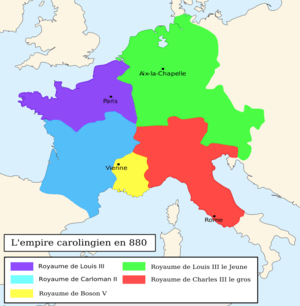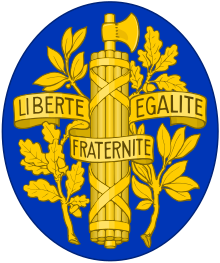Louis III of France
Louis III (863/65 – 5 August 882) was the king of West Francia from 879 until his death in 882. The eldest son of king Louis II and his first wife Ansgarde of Burgundy, he succeeded his father and ruled jointly with his younger brother Carloman II, who became sole ruler after Louis's death. Louis's short reign was marked by military success.
| Louis III | |
|---|---|
| King of West Francia | |
| Reign | 879–882 |
| Coronation | September 879 |
| Predecessor | Louis the Stammerer |
| Successor | Carloman II |
| Born | 863/865 |
| Died | 5 August 882 St Denis, Île-de-France, Neustria |
| Burial | Basilica of St Denis |
| Dynasty | Carolingian |
| Father | Louis the Stammerer |
| Mother | Ansgarde of Burgundy |
Biography
Louis was born while his father was King of Aquitaine and his grandfather Charles the Bald was ruling West Francia. Some doubts were raised about his legitimacy, since his parents had married secretly and Ansgarde was later repudiated at Charles' insistence. When Charles died in 877 and then Louis the Stammerer died two years later, some Frankish nobles advocated electing Louis as the sole king, but another party favoured each brother ruling a separate part of the kingdom. In September 879 Louis was crowned at Ferrières Abbey. In March 880 at Amiens the brothers divided their father's kingdom, Louis receiving the northern part, called Neustria or sometimes simply Francia.

the northern realm ruled by Louis III after the division of March 880 is shown in purple
Duke Boso, one of Charles the Bald's most trusted lieutenants renounced his allegiance to both brothers and was elected King of Provence. In the summer of 880 Carloman II and Louis III marched against him and captured Mâcon and the northern part of Boso's kingdom. They united their forces with those of their cousin Charles the Fat, then ruling East Francia and Kingdom of Italy, and unsuccessfully besieged Vienne from August to November. In 881 Louis III achieved a momentous victory against Viking raiders, whose invasions had been ongoing since his grandfather's reign, at the Battle of Saucourt-en-Vimeu. Within a year of the battle an anonymous poet celebrated it and the king, for both his prowess and piety in a short poem Ludwigslied composed in the Old High German.
Louis III died on 5 August 882, aged around 17, at Saint-Denis in the centre of his realm. Whilst mounting his horse to pursue a girl who was running to seek refuge in her father's house he hit his head on the lintel of a low door and fell, fracturing his skull.[1][2] Since he had no children, his brother Carloman II became the sole king of West Francia and the victor of Saucourt was buried in the royal mausoleum of the Basilica of St Denis.
References
- Le Bas, Philippe (1843). L'Univers, histoire et description de tous les peuples - Dictionnaire encyclopédique de la France. 10. p. 339.
- Nelson, Janet (1994). Charles le Chauve. Aubier. ISBN 2700722612.
- Green, Dennis H. "The Ludwigslied and the Battle of Saucourt", in Judith Jesch (ed.), The Scandinavians from the Vendel Period to the Tenth Century (Oxford: Boydell Press, 2002), 281–302.
- Fouracre, Paul. "The Context of the Old High German Ludwigslied", Medium Aevum, 46 (1985), 87–103.
- MacLean, Simon. Kingship and Politics in the Late Ninth Century: Charles the Fat and the end of the Carolingian Empire. Cambridge: Cambridge University Press, 2003.
- McKitterick, Rosamond. The Frankish Kingdoms under the Carolingians, 751–987. London: Longman, 1983.
- Oman, Charles. The Dark Ages 476–918. London: Rivingtons, 1914.
Louis III of France Born: 863x65 Died: 5 August 882 | ||
| Preceded by Louis II |
King of West Francia 10 April 879 – 5 August 882 with Carloman II |
Succeeded by Carloman II |
